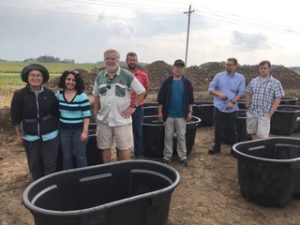Stream + Wetlands (S+W) Foundation is proud to have entered into a partnership with world renowned environmental scientist William J. Mitsch, Ph.D. in an outdoor experimental mesocosm project. Dubbed “wetlaculture” – because it integrates wetlands with agriculture – this multi-year project will study the design of wetlands to decrease downstream eutrophication, including harmful algal blooms and hypoxia, while replacing the requirements of additional fertilization for agricultural production with a recycling mechanism that will return those nutrients to the soil.
A mesocosm is any outdoor experimental system that examines the natural environment under controlled conditions. Mesocosm studies provide a link between field surveys and highly controlled laboratory experiments. Baseline studies involve creating wetland compounds in 30 tubs that will be initially planted with local wetland vegetation to simulate larger-scale wetlands in agricultural settings. S + W’s support will allow the research team to install a mesocosm compound at a site in the Great Black Swamp basin near to the Maumee River in Defiance County.
To read Dr. Mitsch’s article abstract “Solving Lake Erie’s harmful algal blooms by restoring the Great Black Swamp in Ohio” on the ScienceDirect website, click here. Dr. Mitsch has been generously offered to provide a copy of his paper to those who email him at wmitsch@fgcu.edu.

